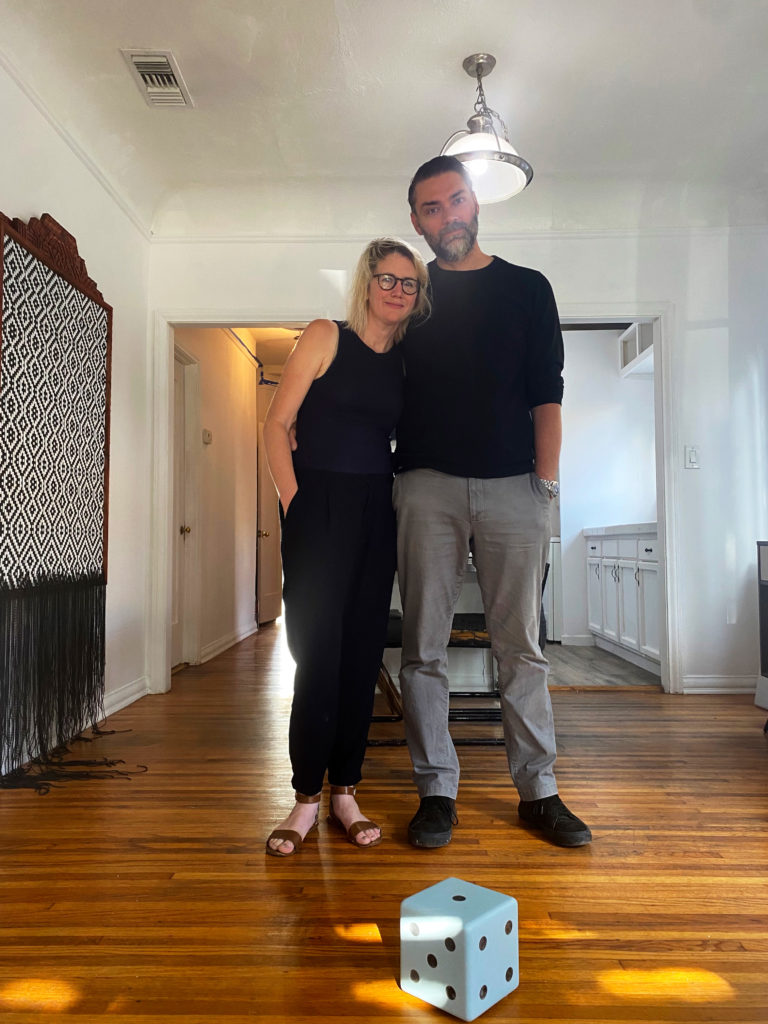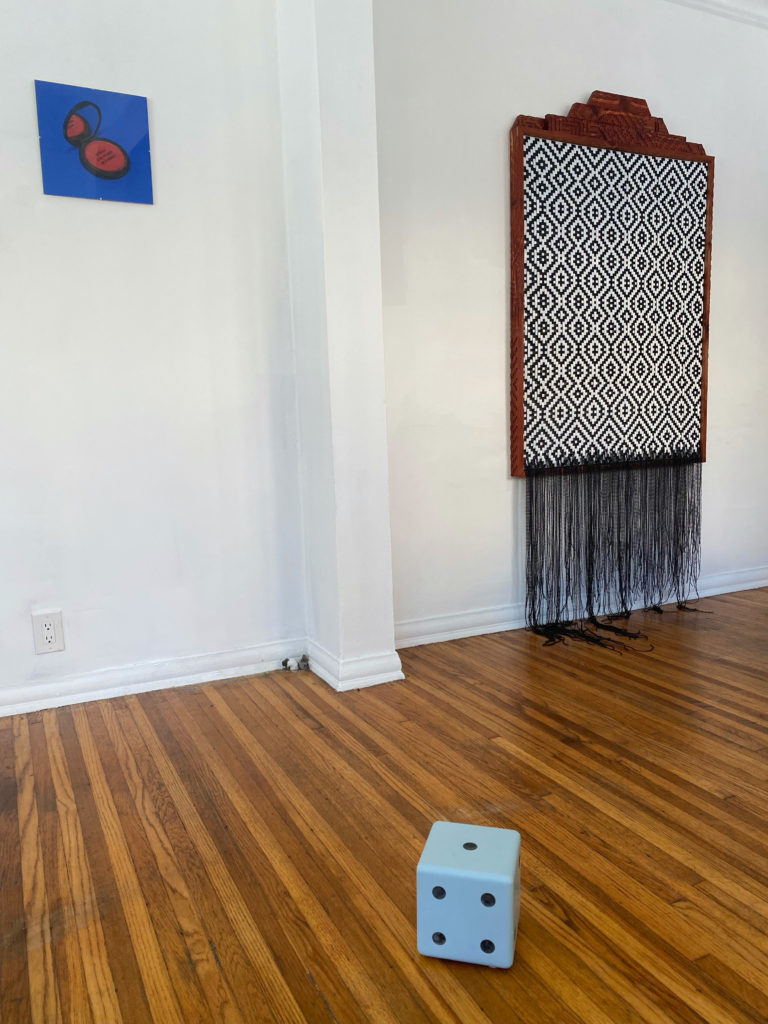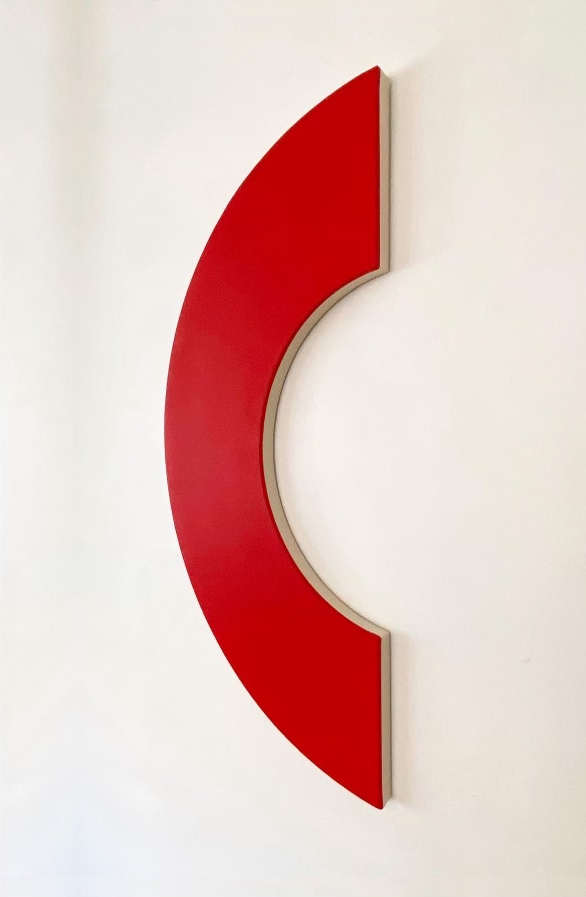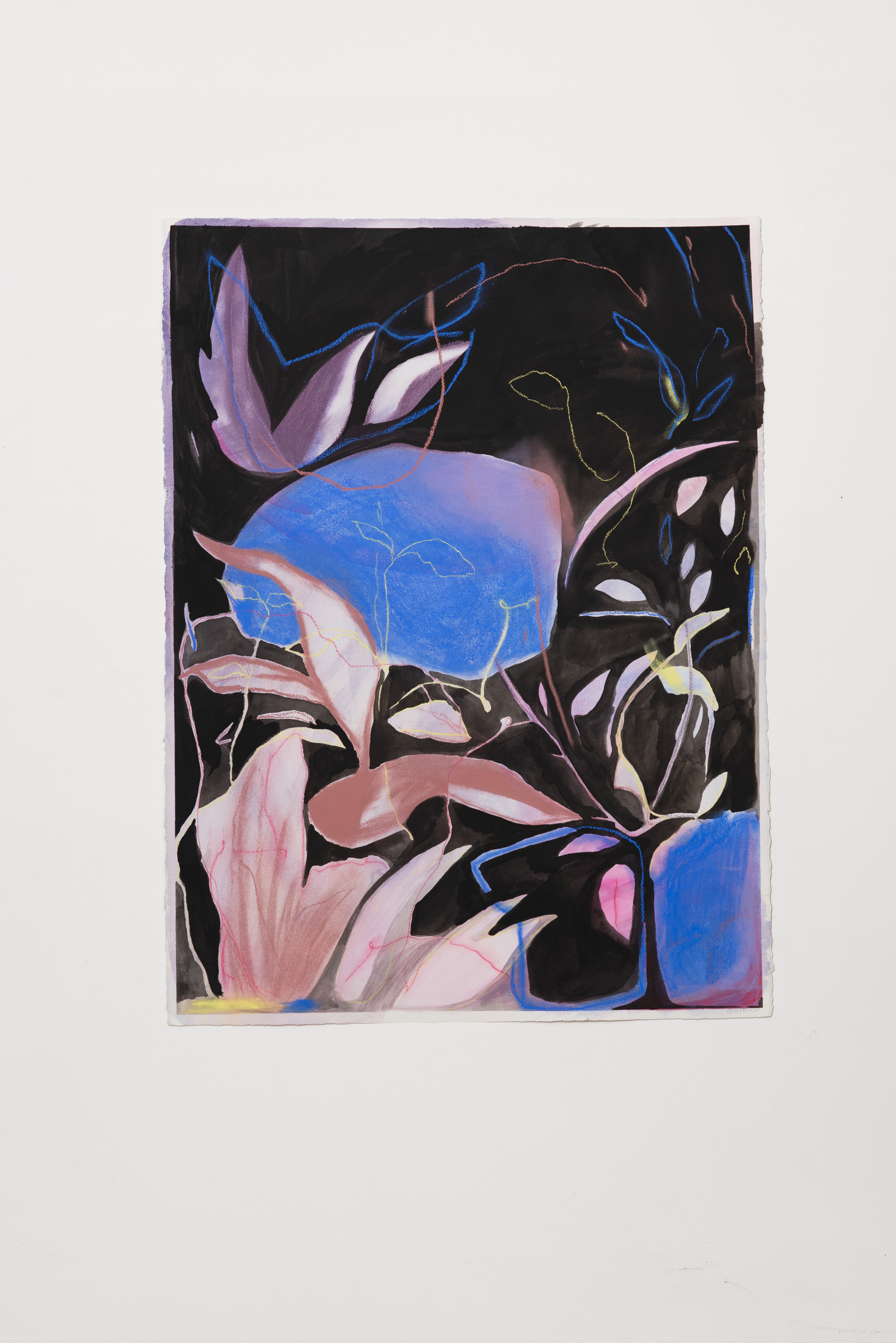
Liz Hirsch and Joshua Smith at 839, Los Angeles, courtesy Jonas Hirsch
839 is a newcomer to the Los Angeles gallery scene, co-founded by writer and educator Liz Hirsch and artist Joshua Smith in their Hollywood home. Liz Hirsch is an Assistant Professor of Contemporary Art/Media Studies at Otis College of Art and Design and was the Andrew W Mellon Curatorial Fellow at Dia Art Foundation for 2016-17. Joshua Smith is an artist known for both his serial monochrome paintings and his political activism—including advocating for Frieze New York to use union labor and proposing a gun violence amendment to repeal the Second Amendment. Smith’s Untitled (Speakers), a set of stacked speakers playing a continuous loop of Roy Orbison’s “Only the Lonely” is part of Dikeou Collection. 839 will kick off its program with a group show “Summer 24” opening June 29.
Interview by Brandon Johnson
Your gallery will be joining an expanding scene of commercial spaces in Los Angeles over the last few years, including locations for many bluechip galleries from other cities around the world. Can you comment on the current Los Angeles gallery scene and how yours fits in?
LH: Well, we want to acknowledge that we’ve only lived in Los Angeles for seven years, but it feels like home to us now. It’s funny because when we moved to LA from New York we ended up renting in a corner of Hollywood that already had a few established galleries like Tanya Bonakdar, Regen Projects, and Various Small Fires. That wasn’t really intentional, but it’s been a nice aspect of the community to date and it makes our home, where we’re opening the gallery, a convenient location for people who are going out to see shows. You’re right though about the explosion of blue-chip galleries in the area recently. While it is a nice thing for the public to have more opportunities to see art and ostensibly for artists to have increased opportunities to show, it’s tragic how high baseline rents have gotten in the city and how the region is simultaneously losing working-class institutions like the 99 Cent stores, of which the Hollywood location was so famously photographed by Andreas Gursky in the 1990s.

Installation view, Summer 24, 839, Los Angeles, courtesy 839
839 will be in your home—a practice with its own lineage. Are there any home galleries past or present you’ve looked to for inspiration? And what are the idiosyncrasies and/or challenges to such an approach?
LH: There is a fascinating tradition of home galleries that have informed our approach: Alfred Steiglitz and 291, Betty Parsons, and Leo Castelli. The intimacy of the experience of seeing artwork in a home is I think so crucial. When I first met Joshua he started organizing Apartment Show with Denise Kupferschmidt, which hosted about a dozen projects, sited directly within people’s homes, mostly in Brooklyn. It was always a thrill to get to peer inside another person’s habitat and see the way a work could activate an ordinary space. Joshua had also run a gallery out of a historic duplex in the Woodbridge neighborhood of Detroit, called Commonwealth. There’s also the townhouse gallery that has been so formative. I remember going to see a David Hammons exhibition at L&M Arts uptown in Manhattan and just being blown away by both the paintings and the setting. We’ve also loved that about a place like Brussels, for example, where so many of the galleries are situated in what once would have been single family homes. Today there are exciting examples of this approach. Adam Marnie is running F out of his home in Houston. I think the biggest challenge involves the balance of the public and the private. We want to welcome visitors into our world while also maintaining a degree of privacy.
JS: And the process of converting domestic spaces into gallery spaces, let alone ones that can exist simultaneously, is a really substantial undertaking. I keep saying it’s like making French press coffee, but with your house.
Your first exhibition is a group show featuring artists mostly based in Los Angeles and New York, many of whom the gallery will represent. Is this meant to be a taste of the program? How did you find these artists?
JS: Totally. The first show will include all the gallery’s artists that we’ll be representing initially alongside a handful of others we really admire. The artists are largely culled from old friends of ours from our time in New York, where we both lived for over ten years, and from our time in LA since 2017. Two of the artists who will be in the show, Abdolreza Aminlari and Kyle Knodell (who recently moved to Berlin) went to the same art school that I did in Detroit and so I’ve been friendly with both of them for over twenty years. Nichelle Dailey is an amazing photographer based in Los Angeles who we met through her work with Lux magazine. Liz worked with another of the artists, Andrés Janacua, for a few years at Los Angeles City College, where he is a beloved studio instructor. One hope with the space and with the group show is to impress upon people that you can make your own communities or your own little worlds.

Joshua Smith, Untitled, 2021, acrylic on canvas, 45.5″ x 21.5″, courtesy the artist and 839
Joshua, we first came to know you as an artist. How does that role influence the perspective of this gallery project?
JS: My experience as an artist makes me think we’ll feel a stronger-than-usual responsibility to uplift and support 839’s artists. We feel strongly about providing our represented artists with the opportunity for repeat exhibitions, opportunities, etc. We won’t tolerate political conservatism at 839 and will maintain a safe space for outwardly progressive and left-wing artists to express themselves, which we feel is of utmost importance to the field and the wider world in this time of genocide, rising fascism, and the attendant censorship of intellectuals that accompanies both.
Clearly art of a political nature will be featured in the space. Are there any other themes to be found across the roster of artists you will be showing?
LH: The artists we’re working with are all exploring form in interesting ways. There’s a lot of abstract work among our artists. Natalie Lerner, Andrés Janacua, Olivia Gibian, Joshua, and to a certain extent the estate of Joshua Caleb Weibley, all make work that uses flat-grounded devices. We probably tend toward minimal and abstract painting and drawing. The photographers we’re working with, Nichelle Dailey and Kyle Knodell, are both kind of classic photographers in a Magnum sense. Both are concerned with people and both make work that is particularly grounded in the places they are made. The estate of Joshua Caleb Weibley represents probably our most overt conceptualist on the roster, but the brainy, humorous spirit behind the work feels a little to us like the heart and soul of the gallery. I often think our artists are artist’s artists. They all have groups of passionate followers especially among other artists.

Olivia Gibian, Untitled, 2018, watercolor, gouche, and pastel on paper, 30″ x 22″, courtesy the artist and 839
Your first solo show in September will be Olivia Gibian. I’m not finding a lot about her online. Can you tell us about her work?
JS: I think the artist Ada Friedman introduced us to Olivia and her work something like ten years ago in New York, when we all lived there. Since then, Olivia moved to LA and we did too. She makes beautiful, largely abstract paintings on paper and occasionally canvas that summon imagery of ponds, flowers, and rocks. Many of the works are made at a very intimate scale, like 5 x 7 inches. The effect is ethereal and transporting. The piece that we’re including in the first group show is a larger framed painting on paper evoking plants and water in rich tones of black, blue, and white. We had imagined that we’d predominantly be showing Olivia’s smaller paintings on paper in September, but she told us the other day that she might be crafting up something new for this show in particular. So maybe we’ll see a little combination of the two. Olivia’s also an accomplished floral designer and we’re all into the idea of uplifting this wing of her practice as well. And she’s a budding surfer! Last, we’re also in a band together called Never Work with her and her husband, Nick Earhart. Olivia plays keys and does vocals. I think people, especially artists, are going to be really excited to see Olivia’s show in September.